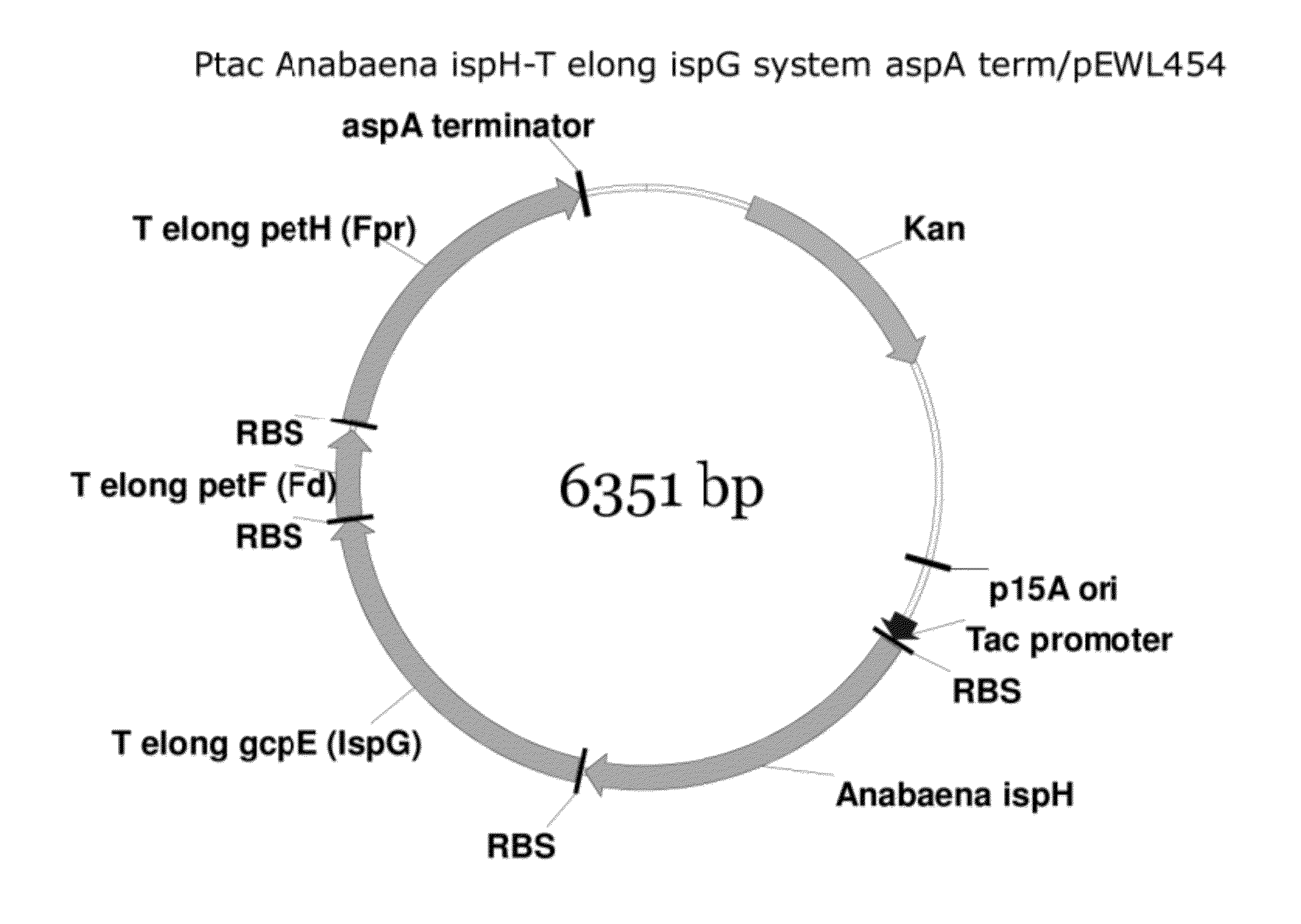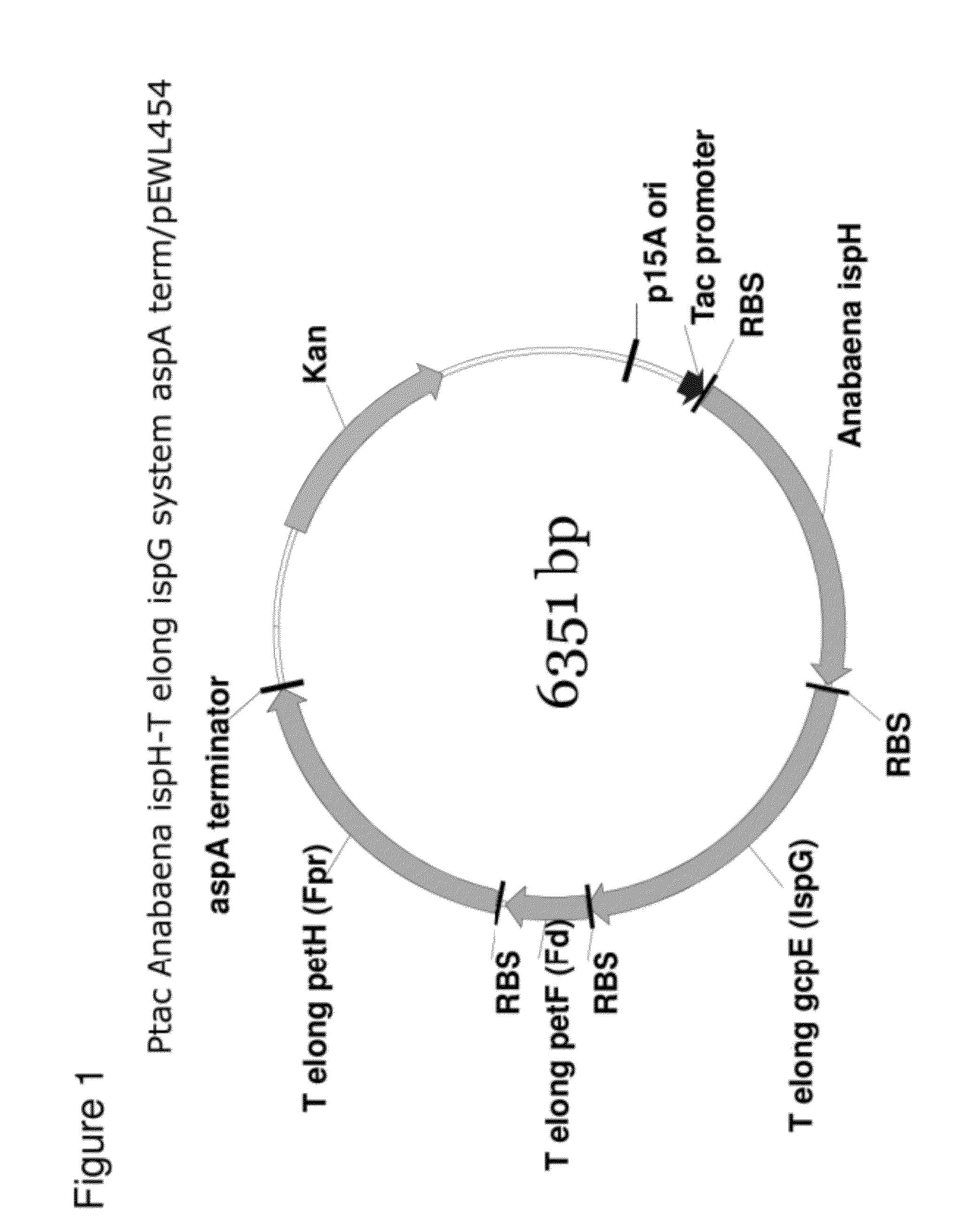Compositions and methods for improved isoprene production using two types of ispg enzymes
a technology of isoprene and enzymes, applied in the field of compositions and methods for improving the production of isoprene, can solve the problems of high cost, time-consuming, and unattractive yield of isoprene from naturally occurring organisms
- Summary
- Abstract
- Description
- Claims
- Application Information
AI Technical Summary
Benefits of technology
Problems solved by technology
Method used
Image
Examples
example 1
Generation of Ptac Anabaena ispH-T elong ispG System aspA term / pEWL454
[0157]Cloning of the T. elongatus IspG System into Ptac Anabaena ispH aspA term / pEWL454
[0158]A DNA sequence harboring the T. elongates IspG system consisting of gcpE-petF-petH present in plasmid Ptac-gcpE-petF-petH / pK184 has been described previously (see U.S. patent application Ser. No. 12 / 817,134 (US Publ. No. 2011 / 0014672), Example 9). Using DNA Polymerase I (Large Klenow Fragment), BamHI, and PstI (New England BioLabs, MA) a 5′ blunt (BamHI destroyed)-3′ PstI gcpE-petF-petH fragment was obtained. The Ptac Anabaena ispH aspA term / pEWL454 vector was digested with SmaI and PstI (New England BioLabs, MA) according to the manufacturer's suggested protocol. The SmaI and PstI cut Ptac Anabaena ispH aspA term / pEWL454 DNA was combined with the final digest reaction harboring the 5′ blunt (BamHI destroyed)-gcpE-petF-petH-3′ PstI fragment and the DNA mixture cleaned using a Qiagen QiaQuick Gel Extraction Kit. Approximate...
example 2
Generation of the Enhanced DXP Flux Isoprene Producing Strain REM F2—18
[0164]Transformation of REM I7—11 with Ptac Anabaena ispH-T elong ispG System aspA term / pEWL454
[0165]The isoprene producing parental strain REM I7—11 was described previously (see U.S. patent application Ser. No. 12 / 817,134 (US Publ. No. 2011 / 0014672), Example 29). In addition to increased expression from chromosomally encoded DXP pathway genes dxs and dxr, the REM I7—11 strain harbors plasmid encoded copies of both fldA and ispG as well as the fldA and ispG loci present within the BL21 genome. The Ptac Anabaena ispH-T elong ispG system aspA term / pEWL454 plasmid was introduced by electroporation into strain REM I7—11. Electroporation was performed using a Bio-Rad Gene Pulser system with a 0.1 cm cuvette, cat. #165-2089. Transformation was achieved by following the manufacturer's suggested protocol. Transformants were recovered in LB broth for 1 hour at 37° C. before plating onto LB agar containing spectinomycin (...
example 3
Large Scale Fermentation of REM F2—18 Yielding an 8.4 g / L Isoprene Titer
[0166]Isoprene production from E. coli cells expressing genes from the DXP pathway and isoprene synthase were grown in fed-batch culture at the 15-L scale using the following reagents;
[0167]1000× Trace Metal Solution (per liter): Citric Acids*H2O 40 g, MnSO4*H2O 30 g, NaCl 0 g, FeSO4*7H2O 1 g, CoCl2*6H2O 1 g, ZnSO*7H2O 1 g, CuSO4*5H2O 100 mg, H3BO3 100 mg, NaMoO4*2H2O 100 mg. Each component was dissolved one at a time in Di H2O, pH was adjusted to 3.0 with HCl / NaOH, and then the solution was q.s. to volume and filter sterilized with a 0.22 micron filter.
[0168]Vitamin Solution (per liter): Thiamine hydrochloride 1.0 g, D-(+)-biotin 1.0 g, nicotinic acid 1.0 g, D-pantothenic acid 4.8 g, pyridoxine hydrochloride 4.0 g. Each component was dissolved one at a time in Di H2O, pH was adjusted to 3.0 with HCl / NaOH, and then the solution was q.s. to volume and filter sterilized with 0.22 micron filter.
PUM
 Login to View More
Login to View More Abstract
Description
Claims
Application Information
 Login to View More
Login to View More - R&D
- Intellectual Property
- Life Sciences
- Materials
- Tech Scout
- Unparalleled Data Quality
- Higher Quality Content
- 60% Fewer Hallucinations
Browse by: Latest US Patents, China's latest patents, Technical Efficacy Thesaurus, Application Domain, Technology Topic, Popular Technical Reports.
© 2025 PatSnap. All rights reserved.Legal|Privacy policy|Modern Slavery Act Transparency Statement|Sitemap|About US| Contact US: help@patsnap.com



